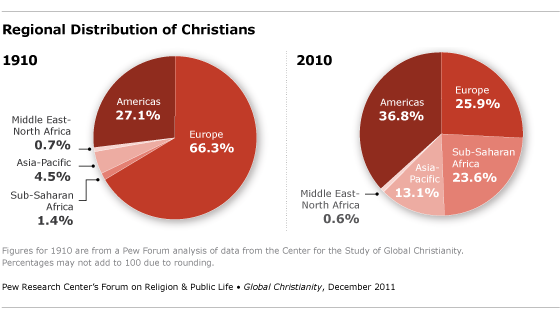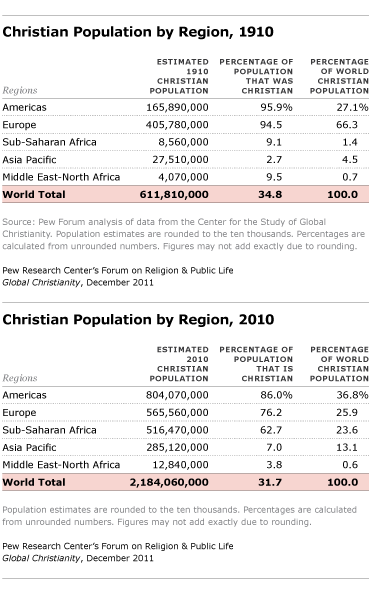Born Again Still Your Son in Latin

A comprehensive demographic study of more than 200 countries finds that there are 2.xviii billion Christians of all ages around the globe, representing nearly a third of the estimated 2010 global population of six.9 billion. Christians are likewise geographically widespread – and then far-flung, in fact, that no single continent or region can indisputably merits to be the center of global Christianity.
A century agone, this was non the case. In 1910, near two-thirds of the world'south Christians lived in Europe, where the bulk of Christians had been for a millennium, according to historical estimates by the Centre for the Study of Global Christianity.2 Today, but near a quarter of all Christians alive in Europe (26%). A plurality – more than a third – now are in the Americas (37%). Near one in every four Christians lives in sub-Saharan Africa (24%), and about one-in-eight is found in Asia and the Pacific (13%).

The number of Christians effectually the world has nearly quadrupled in the last 100 years, from about 600 million in 1910 to more than 2 billion in 2010. But the world'southward overall population also has risen rapidly, from an estimated 1.viii billion in 1910 to 6.9 billion in 2010. As a issue, Christians make upwards about the same portion of the earth's population today (32%) every bit they did a century ago (35%).
This apparent stability, however, masks a momentous shift. Although Europe and the Americas still are home to a bulk of the earth'due south Christians (63%), that share is much lower than it was in 1910 (93%). And the proportion of Europeans and Americans who are Christian has dropped from 95% in 1910 to 76% in 2010 in Europe as a whole, and from 96% to 86% in the Americas as a whole.

At the same fourth dimension, Christianity has grown enormously in sub-Saharan Africa and the Asia-Pacific region, where at that place were relatively few Christians at the kickoff of the 20th century. The share of the population that is Christian in sub-Saharan Africa climbed from 9% in 1910 to 63% in 2010, while in the Asia-Pacific region information technology rose from 3% to vii%. Christianity today – dissimilar a century ago – is truly a global faith. (See globe maps weighted by Christian population in 1910 and 2010.)
These are some of the primal findings of Global Christianity: A Report on the Size and Distribution of the Earth's Christian Population, a new written report by the Pew Research Center'southward Forum on Religion & Public Life.
The written report is based primarily on a country-past-land analysis of about 2,400 data sources, including censuses and nationally representative population surveys. For some countries, such as Cathay, the Pew Forum's estimates besides accept into account statistics from church groups, government reports and other sources. (See Appendix C [PDF] for more details on the range of estimates available for China.)
Christians are various theologically equally well as geographically, the new report finds. About half are Catholic. Protestants, broadly defined, make upwards 37%. Orthodox Christians comprise 12% of Christians worldwide. Other Christians, such equally Mormons and Jehovah's Witnesses, make up the remaining i% of the global Christian population. (See Defining Christian Traditions.)
Taken as a whole, notwithstanding, Christians are by far the world's largest religious group. Muslims, the second-largest group, make upwardly a little less than a quarter of the world'south population, co-ordinate to previous studies by the Pew Forum.3
Nearly one-half (48%) of all Christians alive in the 10 countries with the largest number of Christians. Iii of the top x countries are in the Americas (the U.s., Brazil and United mexican states). Two are in Europe (Russia and Germany), two are in the Asia-Pacific region (the Philippines and China), and 3 are in sub-Saharan Africa (Nigeria, Democratic Congo-brazzaville and Ethiopia), reflecting Christianity's global reach.


Clearly, Christianity has spread far from its historical origins. For case:
- Though Christianity began in the Middle Eastward-Due north Africa, today that region has both the everyman concentration of Christians (nigh 4% of the region'southward population) and the smallest number of Christians (about 13 million) of any major geographic region.
- Indonesia, a Muslim-bulk state, is abode to more Christians than all 20 countries in the Centre East-North Africa region combined.
- Nigeria now has more than twice as many Protestants (broadly defined to include Anglicans and independent churches) as Germany, the birthplace of the Protestant Reformation.
- Brazil has more than twice as many Catholics equally Italia.
- Although Christians comprise just under a third of the world's people, they form a majority of the population in 158 countries and territories, most 2-thirds of all the countries and territories in the world.
- Well-nigh 90% of Christians alive in countries where Christians are in the bulk; only nearly x% of Christians worldwide alive as minorities.
Global Distribution of Christians
So where are the bulk of the world'south Christians today? The Pew Forum study suggests at to the lowest degree four possible answers, depending on how 1 divides upwardly the world:
The Global Due south
In recent years, a number of scholarly books and articles have discussed the rapid growth of Christianity in the developing countries of the "Global Southward" – especially Africa, Asia and Latin America – and debated whether the influence of Christians in the "Global North" is waning, or not.4 A century ago, the Global North (commonly divers as North America, Europe, Australia, Nihon and New Zealand) contained more than than 4 times equally many Christians as the Global Due south (the rest of the world).five Today, the Pew Forum study finds, more ane.3 billion Christians live in the Global South (61%), compared with well-nigh 860 million in the Global North (39%).
The Global Due north
Merely fifty-fifty though Christians are more than numerous in the Global South, the concentration of Christians is much higher in the Global North, where 69% of the population is Christian. By dissimilarity, 24% of the people living in the Global South are Christian. This reflects the fact that the total population of the Global South is about 4.5 times greater than the population of the Global North.

Another way of looking at the distribution of Christians around the globe is by region. Numerically, at least, Europe no longer dominates global Christianity the style it did 100 years agone. Rather, the bulk of Christians are in:
The Americas
Of the world's five major geographic regions, the Americas have both the largest number and the highest proportion of Christians. More than a third of Christians worldwide (37%) live in the Americas, where nearly nine-in-10 people (86%) are Christian. The three countries with the largest Christian populations – the United states, Brazil and Mexico – are in the Americas. Together, these three countries alone account for nigh 1 in every iv Christians in the world (24%), well-nigh the same proportion equally the whole of Europe (26%) and all of sub-Saharan Africa (24%). Although Christians make up a smaller portion of the 2010 population in the Americas (86%) than they did in 1910 (96%), the Americas account for a higher share of the world's Christians (37%, up from 27% in 1910).6

Sub-Saharan Africa and Asia-Pacific
Only sub-Saharan Africa and the Asia-Pacific region now have a combined population of about 800 million Christians, roughly the same as the Americas. And five of the peak x countries with the largest Christian populations are either in Africa (Nigeria, Autonomous Congo-brazzaville and Ethiopia) or Asia (Philippines and Red china). Moreover, the fastest growth in the number of Christians over the past century has been in sub-Saharan Africa (a roughly 60-fold increase, from fewer than ix million in 1910 to more than 516 1000000 in 2010) and in the Asia-Pacific region (a roughly 10-fold increase, from most 28 million in 1910 to more than 285 meg in 2010).
How Estimates Were Generated
The Pew Forum, in consultation with demographers at the International Institute for Applied Systems Analysis (IIASA) in Laxenburg, Austria, acquired and analyzed virtually ii,400 data sources, including censuses and general population surveys, to get in at Christian population figures for 232 countries and self-administering territories – all the countries and territories for which the Un Population Partition provides overall population estimates. (See Appendix A [PDF] for a more detailed explanation of how the estimates were fabricated; see Appendix D [PDF] for a list of data sources past country.)

In many countries, all the same, censuses and surveys practise not incorporate detailed data on denominational and religious motion affiliations. Christian organizations remain in many cases the merely source of information on the size of global movements inside Christianity (such every bit evangelicalism and pentecostalism) and on Protestant denominational families (such as Baptists and Methodists). The figures in this study on pentecostal, charismatic and evangelical Christians and on Protestant denominational families were commissioned by the Pew Forum from the Center for the Report of Global Christianity at Gordon-Conwell Theological Seminary in South Hamilton, Mass., whose researchers generated estimates based in large part on figures provided past Christian organizations effectually the world. Readers should bear in mind that these breakdowns were derived differently from the overall Christian population estimates.

According to the Centre for the Written report of Global Christianity, at that place are about 279 million pentecostal Christians and 305 1000000 charismatic Christians worldwide. (Charismatic Christians belong to non-pentecostal denominations yet engage in spiritual practices associated with pentecostalism, such as speaking in tongues and divine healing; run into Defining Christian Movements.)
In add-on, more than 285 one thousand thousand Christians can be classified as evangelicals because they either belong to churches affiliated with regional or global evangelical associations, or because they identify every bit evangelicals. Since many pentecostals and charismatics are also evangelicals, these categories are not mutually exclusive. (For more details, meet Christian Movements and Denominations.)
Footnotes:
2 Historical figures throughout the executive summary are courtesy of Todd M. Johnson of the Centre for the Report of Global Christianity at Gordon-Conwell Theological Seminary in S Hamilton, Mass. Johnson is co-editor of the Atlas of Global Christianity, Edinburgh University Printing, 2009. (return to text)
3 As of 2010, at that place were virtually 1.6 billion Muslims worldwide, representing 23.4% of the global population. For more than details, see the Pew Research Eye's Forum on Religion & Public Life, The Future of the Global Muslim Population: Projections for 2010-2030, Jan 2011, and Pew Enquiry Eye'south Forum on Faith & Public Life, Mapping the Global Muslim Population: A Written report on the Size and Distribution of the World's Muslim Population, October 2009. Every bit noted in the preface of this report, the Pew Forum is gradually compiling baseline population estimates and projecting future growth rates for the world'southward major faiths. (return to text)
4 See, for example, Philip Jenkins, The Side by side Christendom: The Coming of Global Christianity, Oxford University Press, 2002; Robert Wuthnow, Boundless Organized religion: The Global Outreach of American Churches, Academy of California Press, 2009; and Mark A. Noll, The New Shape of Earth Christianity: How American Experience Reflects Global Faith, InterVarsity Printing, 2009. (render to text)
5 This common definition of Global North and Global South is not a elementary geographic division of the globe into Northern and Southern hemispheres. Rather, it takes into account levels of economic development as well every bit geography. Figures for 1910 are from a Pew Forum analysis of information from the Center for the Study of Global Christianity. (render to text)
6 Figures for 1910 are from a Pew Forum assay of data from the Middle for the Study of Global Christianity. (return to text)
Source: https://www.pewresearch.org/religion/2011/12/19/global-christianity-exec/
0 Response to "Born Again Still Your Son in Latin"
Postar um comentário